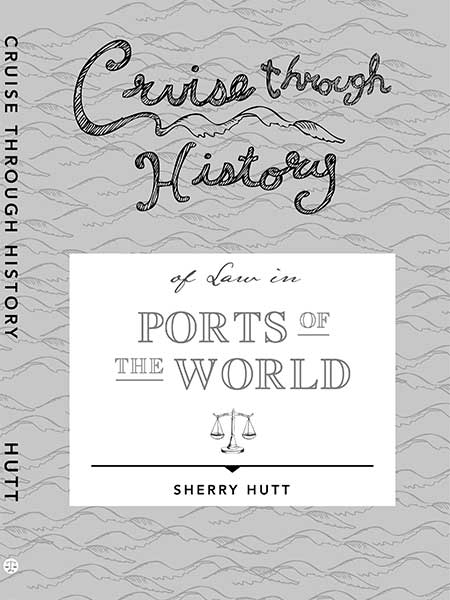For the lawyer seeking the fun side of the law, impress judges, and confound adversaries, with cases from over the last 2,000 years. Non-lawyers will enjoy travel through time when Druids, poets, and knights wrote the laws. Twenty stories in Cruise through History of the Law, in Ports of the World traverse the globe, telling tales of a contract suit brought by Columbus, a domestic relations case enshrined in ancient, epic, Irish poetry, a copyright/intellectual property rights case argued by early Christian monks, ending in a war, and sports teams’ loss of royal support that spurred a riot in which the Hagia Sofia in Constantinople burned, both in the 6th century.
Cruise through History storybooks are collections of short stories grouped by sequence of popular cruise itineraries, into fifteen volumes. As stories move from port to port, they randomly move through time. Stories are all true. They introduce travelers to history and culture of a port through a long-ago, or not so long-ago, resident, whose exploits left a castle, palace, or lovely site to explore. Cruise through History of the Law in Ports of the World crosses itineraries, traversing the globe, presenting a unique casebook of law.
As stories illustrate, rights litigated today were adjudicated in sophisticated venues a millennium or two ago, providing instructive precedent. In these stories, lawyers may find creative solutions to vexing cases. Judges may pause prior to authoring a lengthy opinion, as though elucidating a newly discovered treatise, only to find the matter well decided centuries ago. While quoting Macbeth, Columba, or the Arthasastra may not change outcomes, it will give opponents pause and awaken interest of an appreciative jurist. These stories are intended as fun diversions, inspiring travel destinations.
Travel to the core of legal principles impels definition of natural and common law. Natural Law is often equated to moral principles, developed in righteous life, construed as the basis of religious law. In the time span of these stories, religion is a recent concept. The Stones of Time in Orkney, Shetland, Scotland, and Ireland reveal Natural Law in harmony with the environment. Druids held wisdom for survival on the land.
Common Law is a law of precedent, developed as rules of the community. Besides building roads to traverse their known universe, from Constantinople to England, Romans moved from common law to civil law, when they posted the Twelve Tables of legal principles on the Forum in Rome. Justa of Herculaneum brought a case in Roman probate court for assets of her mother’s estate, taken under advisement by the judge, until Mount Vesuvius covered her city in mud. Justinian, making amends for the riots, rebuilt the Hagia Sofia and issued the Restatement of Civil Law in Corpus Juris Civilus.
Romans were latecomers to Egypt and Sudan, where pharaohs of two dozen dynasties crafted laws written on papyrus and stone. Shabaka, a Black pharaoh of the little-praised 25th dynasty of a thrice united Egypt, preserved in stone words of the first dynasty crumbling to bits on papyrus. Shabaka’s legacy includes 1st dynasty concepts of constitutional monarchy and 25th dynasty historic preservation.
A millennium prior to Greek and Roman contribution to Western law, Sanskrit was the language of literate Africa, India, and Asia. Emanating from the subcontinent of India, the Arthasastra was written in the 2nd century BCE as an authoritative treatise on statecraft, as well as economic and military policy. Wisdom of the Arthasastra is timeless instruction, accessible in English. In 5th century BCE China, Confucius organized community and government affairs, in ways relevant in the 21st century.
Travel to castles in Germany to experience the Schwabenspiegel Code of Fiefdoms. The Code established property rights in ownership and land use. These concepts survive, although bonds of feudal systems were broken in the Renaissance of Commerce, entrepreneurship, and freedom of non-royals to amass more wealth than royals in the Law of Lübeck, founding document of the Hanseatic League. The story of the Hanseatic League is told in ports of Lübeck, Warnemünde, and Rostock, Germany.
Christopher Columbus was a young man of Genoa, sailing the Seven Seas for bankers invested in sugar trade across the Old World. Later, the bank financed his third voyage of discovery to the New World, established a gold standard, and set rules for loans and credit. The bank and its concepts stand today in Genoa. Columbus left home to sail for Spain. Once he discovered a New World for the Spanish monarchs, he brought a court case to protect his contractual rights to hereditary title and income from discoveries.
Dock in Lorient, a quiet port today, to walk cobblestone streets of the French East India Company. This story is a cautionary tale of government involvement in securities, investment schemes, and the implosion of a limited liability company that toppled the monarchy. Learn why the word “bank” is not used in France. Then travel to Amsterdam for the story of tulips as securities in bubble-bursting-bankruptcy. Amsterdam is home to the Dutch East India Company, the first shareholder held trade consortium. DEIC was a model for French and British East India and West India companies from 1602 to its demise when Napoleon inspected the books in 1799 and declared it insolvent.
Cruise through History of the Law sails to the British Isles, porting in Dublin for an early domestic relations dispute, recorded in Irish epic poetry, Táin bó Cuailnge. In dispute was custody of a prize bull, rescued by a tragic hero. Also in Ireland, home of the Book of Kells, is the first known intellectual property and copyright action, between monks, which escalated to battle. Meanwhile, in Scotland, the much-maligned Macbeth, a much-appreciated monarch, issued a civil code, giving fair treatment to all in his realm. The monastery at Iona, where Macbeth lies in the graveyard, was domain of Bishop Adomnán when he crafted a code for non-combatants in war, a model for the Lieber Code, written for President Abraham Lincoln, decades prior to the Hague Convention. In Winchester, England the story venue is the tax court of William I, to this day the location of an annual procession of newly admitted barristers.
Sailing to Norway and Reykjavik, Iceland follows the course of Vikings preserving democratic government tradition in annual Things. Pause along the fissure of rocky earth in Iceland, where Vikings held law courts and legislative sessions since the tenth century.
Cruise to ports of Mexico, Central, and South America, where the zoning decree of Spanish king Philip II in the Law of the Indies is still evident in Spanish colonial towns. Cathedrals anchor main squares of Spanish hill towns along the Pacific coast and throughout South America. Priests, not politicians, were the predominant authority.
As stories float through time and across the globe, they leave travelers and readers with a sense that law is more than a rigorous field of study. Reflecting on application of law in lives lived long ago, is a fun bit of harmless voyeurism. Law texts are compendiums of stories illustrating legal principles. CTH adds in fun. Enjoy your travels!





